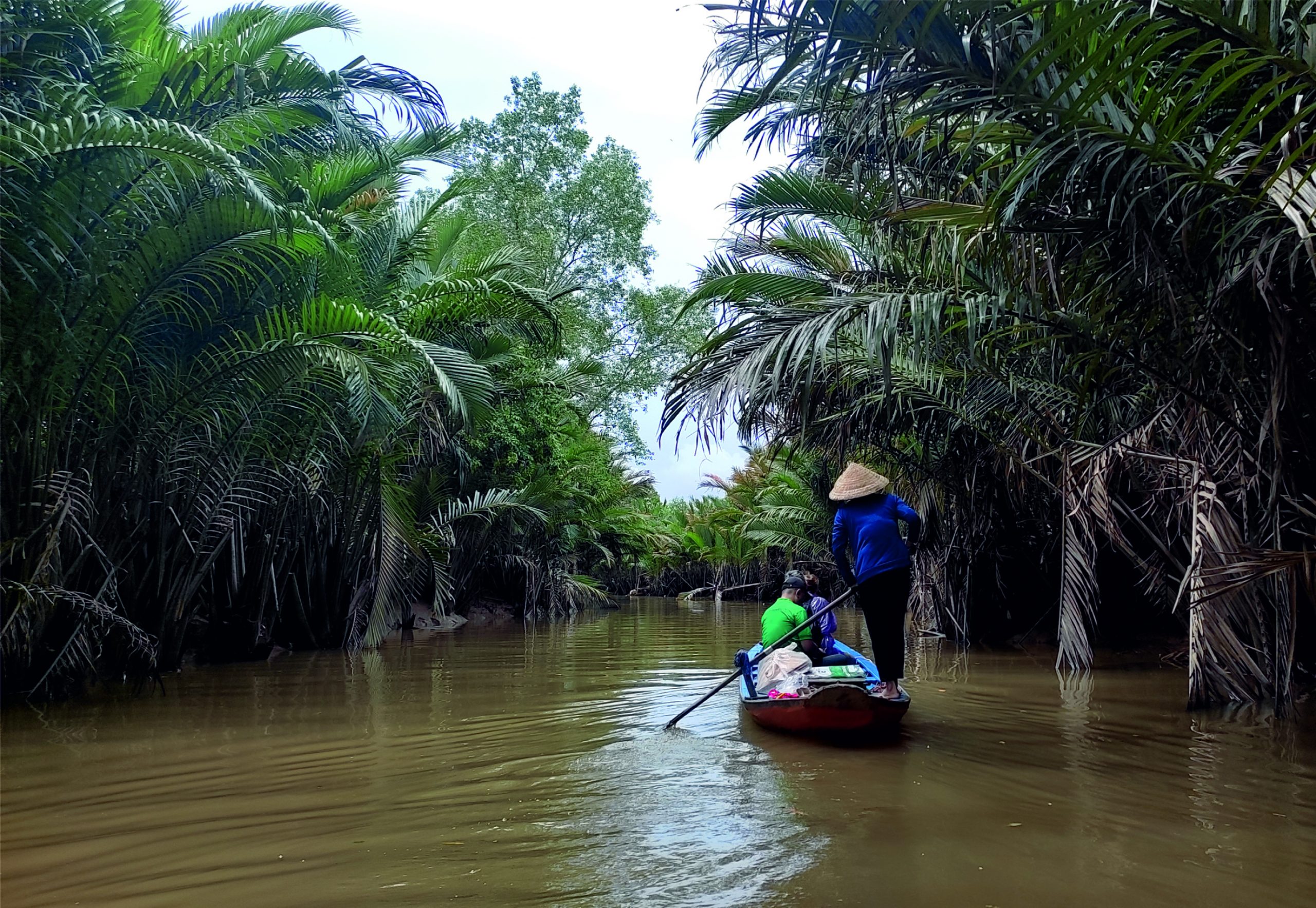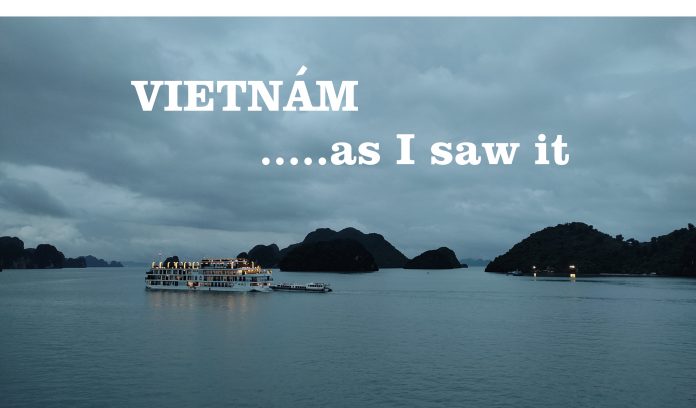Reading Time: 12 minutes
Most of us when we hear about Vietnam are reminded of the war and the horrific stories we have heard of, but these days it has become one of the hottest tourist destinations. So I was there too with a group of friends. It’s amazing to see how they have overcome the destruction and devastation, rebuilt and redeveloped with the help of friendly countries (like India). After the much damaging impact of SARS and then COVID, tourism started picking up last year and now it’s booming.
Here I do not intend to give you a travel itinerary which your travel agent or tour organiser or internet will tell you. I would rather share my experiences and observations, to prepare you as to what to expect and enjoy to the hilt. The place is full of Japanese, American and Australian tourists as well as many Indians (few by comparison though.)
We landed in HANOI via Singapore. After clearing immigration etc. it took us more than an hour to our hotel. A good one in the middle of a busy street in the central part of the city, just like many more. Not far from the Old Quarter and quite like any street in Karol Bagh with different stuff in the shops, but the crowd and the mentality of haggling just the same!
Our first outing was to HA LONG BAY… a 2 hour drive from HANOI. HA LONG BAY is in northern east Vietnam and is popular for its emerald green waters and thousands of limestone islands (and caves) topped by rainforests making the area look blue and green and a pleasant site to look at. To take an overnight or longer Cruise on one of the junk boards or luxury ones is a great option to enjoy the surrounding beauty of the 3000 odd big and small Islands. Almost 1000 of them have names and specific features depending on their shapes like fighting cocks, Monkey Island, stone dog or teapot etc. Their names also depend on things that grow there like coconuts or oranges. Some of the activities that you can do there are like visiting the caves or boating through them under the cave like arches within the Islands. This region is very popular for Kayaking, Scuba Diving, Rock Climbing and Hiking. This area is also known for some of the best pearls in the world. Varieties you can get are white, pink, purple and black.
Two of the biggest islands are named CATBA and TUANCHAU. Some islands now have a path and steps to climb up to a viewing point for visitors to absorb the natural beauty of the silent blue waters and the lush greenery of the rain forests on top. In September to November there are almost 400 Cruise Liners in the Bay. You can find one to suit your pocket. February is the busiest season as it coincides with the Chinese New Year.

While you drive through the countryside you just can’t miss the uncountable roadside Bonsai nurseries. Hundreds of them line the roads on both sides. You cannot buy and carry back home, so don’t stop, just feast your eyes! Another thing you can’t miss in the various roadside workshops and sale points for a variety of Buddha and other sculptures and Temple like structures in all shapes and sizes and colours. People really have an artistic eye and taste and decorate their homes with these artefacts made from stone which is finely crafted. 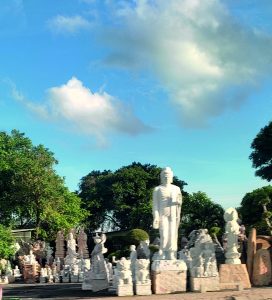
One is also amazed to see the number of two wheelers zipping by. Can’t help appreciating the fact that each and every one wears a helmet, even children are made to wear helmets. At every traffic junction, we saw so many two wheelers standing in a disciplined manner. While the red light was on, not a single person tried to jump the light! No one seems to be in a hurry to get anywhere and nobody blows the horn – they all drive calmly and as per the prescribed speed limits. 
On talking to our guide on our way to HOI AN, we got to know that it’s as easy to buy a two wheeler as it is to buy vegetables at the roadside, if you have the money and licence of course! Every second person owns a two wheeler, which means to every 1000 persons there are 500 vehicles. As I mentioned earlier about the extreme road discipline obviously we saw no road rage or accidents. The other observation is that the Vietnamese are very calm, cool, soft spoken people. They are patient and gracious. It feels as if they have the peace and quietness and serenity of Buddhism actually flowing in their blood through the air they breathe. The public in general is also laid back and love to just sit around and watch the world go by. The city streets are lined with roadside eateries, with the majority of the chairs kept on the footpath facing the road almost like a theatre. Even if there are tables in front they all face the road. Outside smaller shops people just sit around – relaxing, chatting and eating noodles or sticky rice which are their staple foods. They eat noodles anytime of the day, breakfast, lunch and dinner. 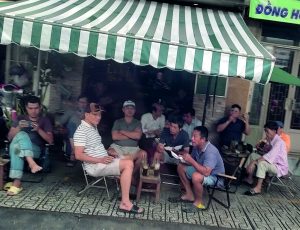
HOIAN is a coastal city and probably has more attractions than HANOI. It was our luck to be there during the Mid October Moon Festival. It is time for the full moon and we saw some beautiful moonscapes en-route to the old quarter and the Lantern Street. It was so festive… almost like our Diwali. There were beautiful lanterns lit up and decorating the streets, which also had many local food stalls on both sides. People were sitting in groups playing music at various street corners. We also saw the Dragon dances on the road. An exhilarating experience with two or more people clad in dragon-like cute costumes teasing people and playing with children as they romped the streets while tourists stopped them to click selfies. 
Driving through the countryside during the day we realise the importance of the mythical Dragon. Even bridges made as early as the 16th Century by the Japanese, have been constructed to resemble the up and down contours of a dragon’s body.
BA NA Hills is one of the greatest attractions near HOI AN. After a drive of about an hour through the magnificent countryside it takes you to the base of these hills. It’s a tourist activities centre which has been developed recently. It is made fantastically, well planned, well designed with so much variety in places and activities for visitors of all ages. The entire landscape of BA NA Hills is somewhat like Disney World. While it’s marked as a theme park there are a lot of things to see and experience. We found the cable car ride most thrilling. The longest and the most sophisticated ride in the world, lasting almost half an hour. To reach the cable car station you have to go up 8 to 10 tall escalators. Apart from the natural scenes you also see huge mountain-side rock-cut sculptures. It is breathtaking. The cable car takes you over beautiful streams and mountains which remain misty and cloudy. There are many man-made wonders there like the French village with cobbled paths and huge castle-like structures just out of a fairy tale. 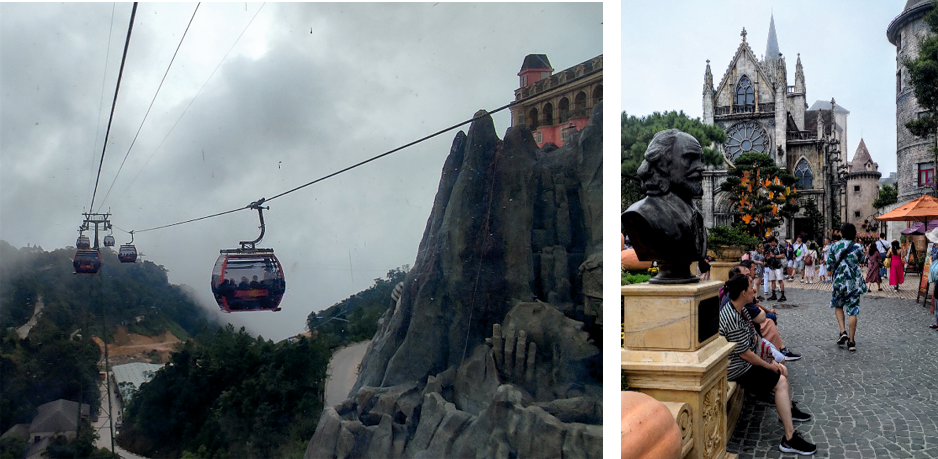
The Golden Bridge floating above the clouds, suspended by a pair of giant stone hands is a novel piece of architecture. There are some gigantic and surreal stone sculptures all around and ornate gardens and temples. The Chinese garden and peacock Garden especially looked beautiful with the colourful flowers in full bloom. An imposing statue of a sitting Buddha and the prayer hall nearby attract many religious Buddhists. The sheer size of everything is mind boggling.

There were so many people that it was easy to get lost. At various places, we noticed many families wearing matching clothes. 
Unfortunately we didn’t have enough time to see and experience each and everything. Actually one day is not enough, so one has to be selective. They say it rains there every afternoon, so we were advised to return to our taxi car by 4:00 p.m. (If you have the inclination to stay overnight there are many hotels atop the hills which can be booked in advance.)
A must for everyone who visits HOI AN, is the HOI AN Memories Show. It’s a wonderful riverside entertainment zone. No games or rides but cultural performances about the history of the place. Remember it was the time of Mid-October-Moon-Festival, so the dances and other shows were awesomely complimented by a big bright full moon as a backdrop. All the presentations like the romantic moon dance, and the historical narrative mesmerising. The rides to and fro through the city in the E-vehicles are very equally enjoyable.

MY SON HOLY LAND or Sanctuary is another destination close by to HOI AN towards DA NANG. This place has the historic ruins of the 13th century. What we saw were ancient brick constructions, largely in ruins now. .. But a must see for people interested in art history and archaeology. This is a religious centre of the Champa Kingdom, a sophisticated Civilization which swayed over this region from the 4th to the 13th centuries. We were pleasantly surprised and proud to see this was the site of an ancient Hindu Civilization and this among many other ancient sites is being renovated and maintained by The Archaeological Survey of India (ASI). There was a big Shivling inside one of the temples and so many idols of Lord Vishnu, his various avatars, Ganpati and many more deities and apsaras. We also witnessed an amazing sunset in the backdrop. The walk along forested paths and the ruins is calm and soothing, while you hear the chirping of birds one last time before the night sets in.
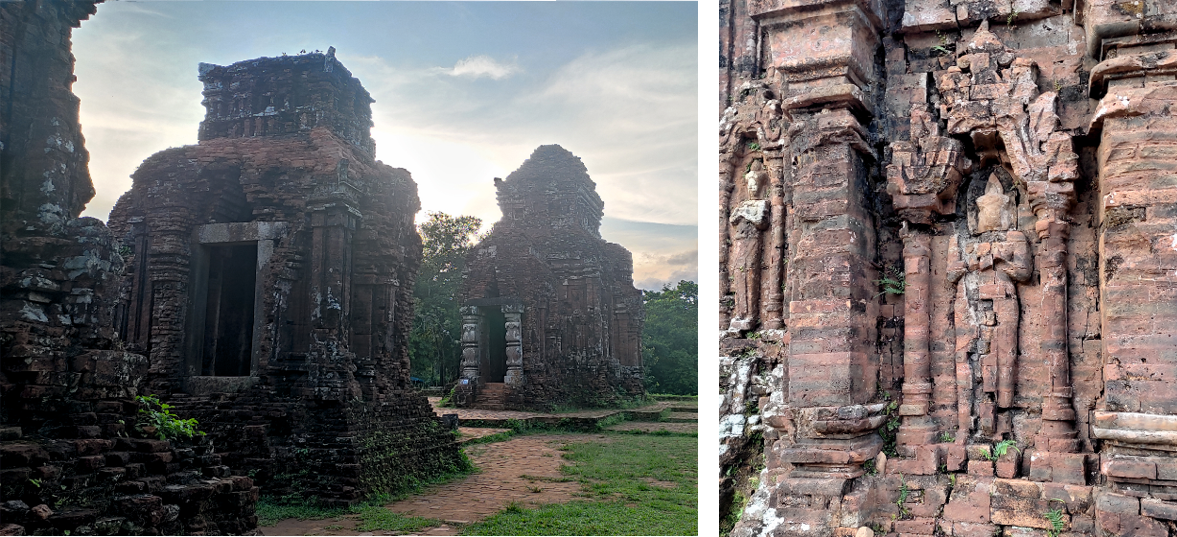
Later we visited the popular HOI AN night market and picked up some souvenirs. Worth a visit, /though we had to haggle a lot. A visit to the old city and a drive through its various criss-crossing streets was necessary to get the feel of the local life, the markets and the street food which are very popular. Of course it’s a non-vegetarian’s delight. I’d like to caution vegetarians about the aroma of the street food which beckons those willing to try the local food can be quite intimidating to strict vegetarians, leave alone the sight.
The next day we took a flight to Ho Chi min-city earlier known as SIAGON and many people still like to call it that. A lot of time went in transit before and after the flight and not much time was left to do anything more. Late evening we could catch the extraordinary, richly curated AO SHOW at the Opera House. The show depicts the charming beauty and cultural richness of Vietnamese life in the countryside. The show is a unique mix of Bamboo Circus, acrobatic acts, dances and the theatrical visual arts. Brilliantly performed by a world famous group. Sorry no photography was allowed. The Opera House building has its own old world charm and added to the beauty of the show with its beautiful ambience. Again due to too many things to see, and time was short, so we had to choose and missed seeing the water puppet show which is also very popular it seems.
HO CHI MINH CITY is famous for the CHU CHI tunnels. This is also a historical site where the locals hid and lived in underground tunnels during the war. Very informative trip, but depressing I thought. Especially to know how and why these tunnels were constructed and how the Vietnamese survived in the harsh war time conditions for long periods. These hand-dug tunnels were used by soldiers for hiding, communication and supply routes. The tunnels changed the course of the Vietnam War. The well camouflaged entrance holes lead into a network of incredibly narrow tunnels that stretch for over 200 km connecting command posts, hospitals and shelters. The tunnels helped the Viet Cong soldiers to launch surprise attacks at their foes. Made and used since 1946 during the French-Indo- China war, they are narrow and deep, best avoided by people who have claustrophobia.
HO CHI MINH or SIAGON CITY is a vibrant, buzzing, one time capital city where modern skyscrapers and incense infused Pagoda temples coexist peacefully. There are many classical style landmarks such as the Notre Dame Cathedral, The Opera House and the Ornate City Hall as well as the art-deco Post Office.
The Post Office is unique. We visited the 110 year old post office. It’s one of the most interesting places. Not only is it housed in a heritage building it has a colonial look and feel, with the vibrancy of modern time both together. The open courtyard invites everyone to pose for photographs with the imposing building seen in the background. Once you get in through the grand arched entrance you find a colourful market in the front and on both the side passages, curios being sold. It is a heaven for window shoppers who can spend a whole day in the passages where there is hardly any place to move. There are few shops of big brands flanking the two sides of the main hall. In the centre part are displayed postage stamps, coins, currency postcards, letters etc and other memorabilia of bygone times. It is like a mini walk through a Museum of display tables. What really got my attention was the live and running post office along the back wall and the sides of the hall. Here are counters for sending and receiving mails, selling counters delivery and receiving counters for post, letters and parcels. Another long counter with computers and internet connectivity and many people sitting using them. Also there was an ATM and if I remember correctly and a money exchange counter. Just outside the post office is the old Cathedral which is undergoing renovation currently. 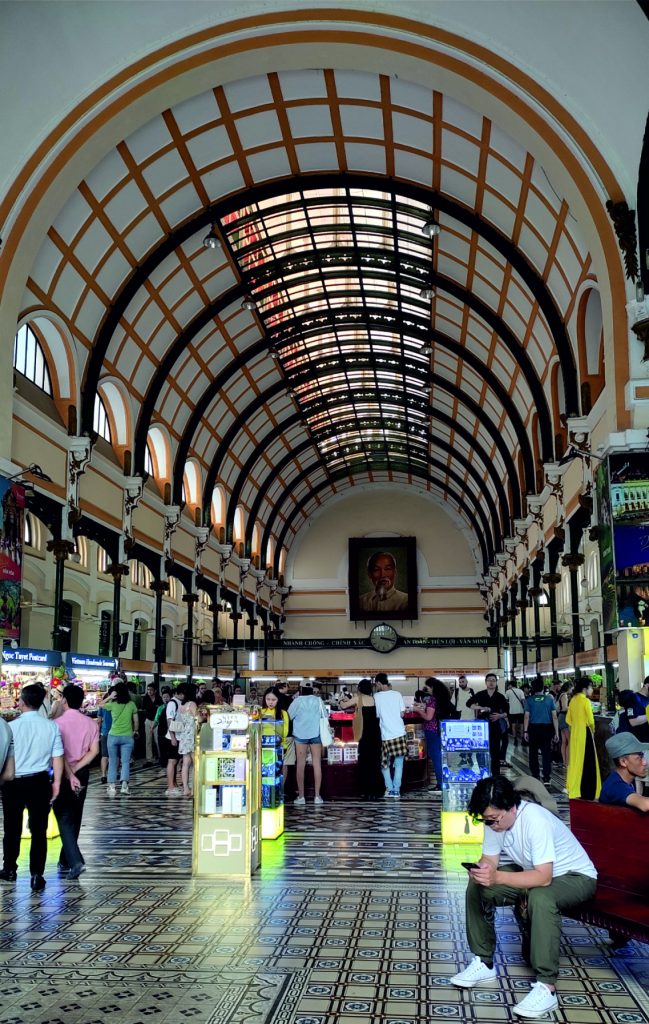
The tour of the SIAGON Palace and other historical places were interesting too. The Reunification Palace famously stormed by tanks in 1975 (which are still there and we could see them in the sprawling gardens of the palace) also has a war plane on the terrace of the palace for the king which was used for his escape. Apart from other usual things which museums house, the palace has an underground Command Centre, Telecommunication setup with a Ham Radio and hidden tunnels for the authorities to escape at the time of emergency or attack.
On our last day in Vietnam, we visited the islands of Mekong Delta to see the rural life there. Mekong is a major rice producing province and rice is exported from here to destinations across the world. A trip to the Delta area is a must if you want to see the real life of the people away from the hustle bustle of the big cities. Mekong is Asia’s third longest trans-boundary river which passes through China, Myanmar, Thailand, Laos, Vietnam and Cambodia after starting from the Tibetan Plateau. In Phnom Penh three other rivers meet Mekong before it reaches the South China Sea.
In the islands of Mekong Delta we also visited a coconut workshop as the islands are full of coconut trees so the locals have started making the best of their advantage. The pulp is extracted carefully and candy made from it in different flavours, whereas useful and decorative products are made from the shell. They also have bamboo plantations and products are also made and sold. Instead of transporting raw material to the mainland different things are made at base providing employment and better value to the locals.
The islands are also famous for the output of tropical fruit. We got to taste some exotic ones, while we were treated to some lively local musical performances by the people. We were told that these islands grow and export 40 types of tropical fruits during different seasons.
There are four main islands. Tortoise Island, Dragon Island, Phoenix Island and the biggest is Unicorn Island. The boat rides through the mangroves in the canals connecting the islands and going deep inside one was good fun and quite adventurous. The transition from the jetty to a steam boat and then to a smaller local rowboat and then again landing, getting on and off the islands was not very comfortable for most of us. One should be wearing well-fitting footwear, preferably shoes. Sandals are not a very good idea for these outings. Clothes should be cool and a bit loose. Ideally cotton shirts with full sleeves to avoid sun tanning and mosquito bites and a nice wide hat is good, the sun feels hot. (We Indians drink a lot of water but were shocked as we had to buy water everywhere, even during a meal at a fine dine restaurant. So sensibly drink and use the one little water bottle that the hotel gives you every day. Coconut water is the best alternative to keep yourself hydrated as it is easily available everywhere.) Don’t forget to carry your raincoat or umbrellas. You never know when it will be needed. It rains almost every afternoon. Even a walking stick is always helpful at such places. (IMAGE 23)
Some of these things may be common knowledge for frequent travellers, but they are useful tips: You must keep your Passport and Visa papers with you at all times. Money, credit cards, mobile phones etc. safe with you, goes without saying. Best is to keep a waist pouch with all these and wear it all the time. HO CHI MINH CITY is well known for pickpockets.
Communication with the locals was a problem we faced but soon learnt the solution. We can download a language translator on our phone. Ideally do it before you start your trip. When you need to talk with someone or need something, speak into the app and it will translate into the required language text and you can show it to the person. Most of them in Vietnam knew little English and they are in the tourism industry but even that percentage is low.
Conversion of currencies is another problem we face. First from Indian to USD and then to the VND that is Vietnamese DONG. The VND is roughly 24 million to 1 USD.
